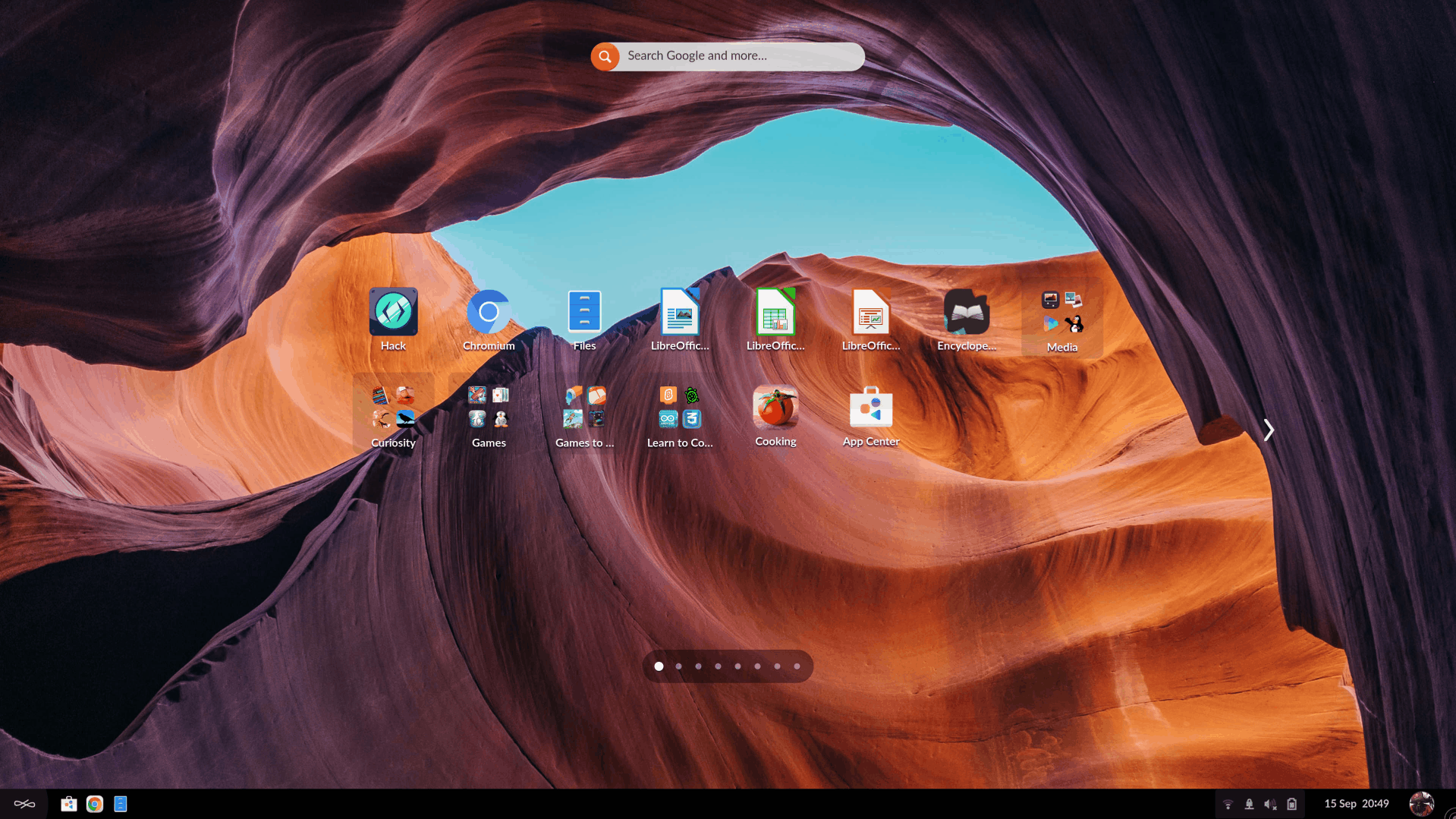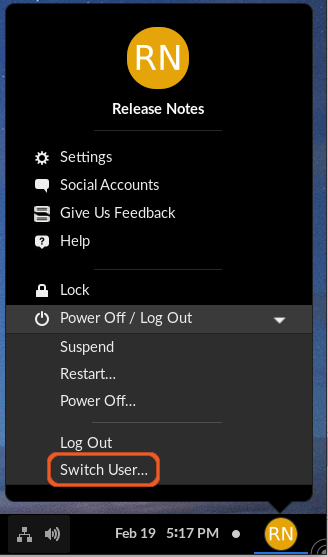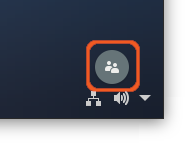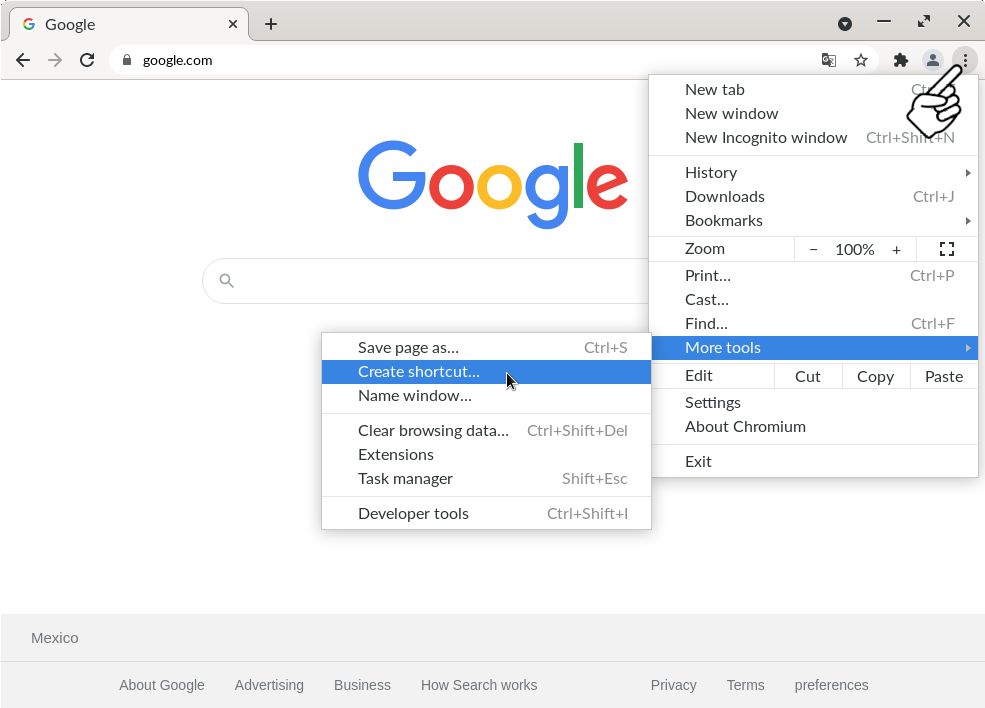Endless OS 4.0.0 was released on November 22nd, 2021. Download it from our website. Most existing Endless OS 3 systems can be upgraded as with any other OS release.
If your computer takes a long time to start after upgrading to Endless OS 4, please click this link for help.
¶ Improved app grid navigation

Since Endless OS 3.9, all apps installed on your system have been shown on the desktop across two or more pages of icons. We have heard feedback that it is hard to discover and switch between pages: many users were not aware there is more than one page.
To address this, Endless OS 4 adds clickable arrows to navigate between pages, and makes the row of dots indicating the number of pages more visible, even against complicated wallpapers.
¶ New default wallpaper
As seen above, Endless OS 4 includes a new default wallpaper: scenery of mountain canyon by Ashim D’Silva. New users and existing users who have not changed their wallpaper will see this new wallpaper; it is also available in Settings → Background for existing users.
¶ Fast User Switching
It’s now possible to switch to a different user while another user is still logged in, by choosing a button on the lock screen or in the user menu.


¶ Driverless printing
All configured printers are removed as part of the upgrade to Endless OS 4. Instead, printers which are connected to your computer or are on the same local network should now be automatically discovered, provided they support Internet Printing Protocol. You can manually readd your printer using Settings → Printers if you have issues.
Some applications may show the same printer more than once in the print dialog. This is a known issue. Both of the entries should work.
Further documentation on printing in Endless OS is available here.
¶ Long-term support
With Endless OS 4, we are introducing a long-term support version of the OS, which will be supported for a number of years even after Endless OS 5 is released.
By default, Endless OS 4 systems will automatically update to Endless OS 5 when it is released, as with all past versions of the OS. However, it is now possible to remain on Endless OS 4 and continue to receive critical bug fixes and security updates even after Endless OS 5 is released, keeping the same OS functionality and appearance for several years.
Please see the Long-Term Support documentation for more details, including how to configure a system to use the LTS version of Endless OS.
¶ OS Platform updated
We have updated our low-level software platform, for improved hardware support, performance, and stability
- Linux kernel 5.11 and updated linux-firmware, bringing support for the latest PC hardware and several fixes to existing drivers and core kernel code.
- Raspberry Pi 4B 8GB RAM is now supported. We previously supported only the 2GB and 4GB RAM models. Graphics and WiFi performance is improved across all Raspberry Pi 4B models.
ARM64 support is still considered to be in a preview state.
- NVIDIA driver 460.91.03, adding support for new NVIDIA graphics cards.
- Added support for L2TP and OpenConnect/AnyConnect VPNs.
- OSTree 2020.8 and flatpak 1.10.2, with some performance improvements for OS and apps updates.
- Switching from fake-hwclock and ntpd to systemd-timesyncd for monotonic clock and time synchronization.
- Updated bootloader components (shim, GRUB) to add support for the new SBAT secure boot revocation mechanism.
- Many other OS platform updates inherited from Debian Bullseye.
¶ Built directly against Debian Bullseye
Before Endless OS 4, we at Endless OS Foundation used to copy the source packages for all the packages we used to construct Endless OS to our infrastructure (OBS), and build them ourselves. This would happen when we started working on a new Endless OS series (e.g. Endless OS 3.9), and then updated several times along the lifecycle of each series. While this approach gave ultimate control of what goes into each version of Endless OS we built, with 4091 packages for Endless OS 3.9 -- plus another 69 we maintain as git repositories -- it was very time-consuming, even with mom's help.
For Endless OS 4 we revised this approach and decided to pull packages we do not modify directly from Debian, instead of building every single package ourselves. While we still have to keep the same infrastructure, only building the packages we need to customize for Endless OS, together with a team-wide effort to minimize our upstream divergency, reduced the number of packages we need to maintain for Endless OS 4 to around 120.
This move reduces the level of control we will have over every bit that is included on each release of Endless OS. However, it frees up valuable engineering time from deciding whether we should update to the latest version from aalib or gzip, then potentially spending time looking into why some of these builds failed (spoiler, most of the time is some silly dependency issue). Additionally, rebuilding code that has already been built hoping to get the exact same output that is already publicly available is just wasteful and does not feel right.
Luckly, Debian offers a very sturdy and stable base, so we don't expect the loss of control mentioned in the previous paragraph to become a problem. Also, since Debian Bullseye has just been released as stable, we can expect fixes for security vulnerabilities and critical bugs to be backported to the Bullseye packages, which we can then bring to Endless OS simply by building a new release.
¶ Removed functionality
¶ Shared account
The Shared Account is not longer created by default on new systems. This account was not widely used and it interacted badly with Parental Controls being configured in initial setup.
On existing systems which upgrade to Endless OS 4, the Shared Account will be preserved, but it will no longer have its Chromium profile and trash cleared between sessions, and Chromium will no longer be configured not to save passwords. (In fact, removing the Chromium profile had already stopped working in 3.9.2 when Chromium was moved to a Flatpak.)
¶ Built-in remote desktop viewer
Previous versions of Endless OS had a Remote Desktop Viewer app (codenamed 'vinagre') built into the OS. This app is no longer maintained by its authors and has been removed from Endless OS 4. There are several alternatives available in the app center, including:
Connections, a simple app which supports accessing remote systems using RDP and VNC
Remmina, a more advanced app, which supports accessing remote systems using RDP, VNC, NX, Spice and SSH
Thincast, which supports RDP connections
Support for sharing your desktop over VNC on the local network continues to be built-in. It can be configured from Settings → Sharing → Screen Sharing.
¶ Built-in desktop shortcuts for websites
Endless OS 3.9.x had desktop shortcuts for Duolingo, Facebook, Gmail, Twitter, WhatsApp, and YouTube built-in. While convenient if you use these services, these shortcuts could not be removed from the desktop icon grid if you wanted. These have been removed in Endless OS 4 and will only be added to the desktop if you choose to.
In some cases there may be apps in the App Center that you can install for these services; otherwise, you can add a shortcut to the desktop using the Chrome or Chromium browsers. To add new shortcuts using Chrome or Chromium, first launch the browser and navigate to the website you want to add a shortcut for, then click on ⋮ Menu > More Tools > Create Shortcut.

¶ Chinese Zhuyin input method
The IBus-Chewing input method for Chinese Zhuyin was removed as it is no longer actively developed. Users should reconfigure their input methods to use ibus-libzhuyin instead, which continues to be included in Endless OS.
¶ Automatic Chrome downloader
Previous versions of Endless OS had their default browser set to Google Chrome. For licensing reasons, we cannot pre-install Google Chrome in Endless OS, so it was automatically installed when the computer was connected to the internet for the first time. Because of this feature, the Chrome app icon was already present in the desktop, even if the computer was not connected to the internet yet.
In all new Endless OS 4 installations, Chromium (the open-source version of Chrome) is the default browser, and it comes pre-installed. Chromium provides essentially the same feature-set as Chrome, except for Chrome Sync which Google does not support in third-party builds.
On Endless OS 4, Chrome will never be automatically downloaded. The Chrome icon will be present on the desktop only when it is installed by the user, just like any other app in the App Center.
In systems where Chrome is already the default browser, this setting will not be changed to Chromium when you upgrade to Endless OS 4.
¶ End of hardware support
- A small number of Endless-branded computers use a "split disk" configuration, with the operating system stored on an eMMC device and the apps stored on a built-in SD card. This configuration is not supported by Endless OS 4, and computers with this configuration will not receive the upgrade.
- ARM64 devices, such as Raspberry Pi 4B and PineBook Pro, are supported by Endless OS 4, but cannot be upgraded from previous versions to Endless OS 4: you must reinstall with a fresh copy of Endless OS 4.
- A few laptop models with hardware that are not well supported by the newer OS platform in Endless OS 4, and that work better with Endless 3.9, will not automatically update.
¶ Other improvements and changes
-
Rhythmbox is now installed as a Flatpak. Previously, this music player app was distributed as part of the OS, and could not be uninstalled or disabled through Parental Controls. Once the upgrade to Endless OS 4 is done, any playlist you had will be lost. We recommend that, if you want to keep them, make a copy of your playlists from the following hidden directory:
.local/share/rhythmbox/. Once the update to Endless OS 4 is performed, you can copy them to the following directory:.var/app/org.gnome.Rhythmbox3/data/rhythmbox/. -
Cheese is now installed as a Flatpak. This fun webcam app was previously labeled “Selfie”. This change means it can be uninstalled, disabled through Parental Controls, and updated separately to the rest of the OS.
-
Icons reverted to GNOME's defaults. This brings higher-resolution icons and better visual consistency among apps from the GNOME family.
![]()
- End-user documentation refresh.
- Separating the OS and Flatpak apps into repositories. Previously, the operating system and Flatpak applications were stored using the same "repository" on disk. As part of the upgrade to Endless OS 4, these are moved to two separate repositories, which is a more standard configuration and may improve the reliability and performance of app installations slightly. The migration process to this new configuration causes the first reboot into Endless OS 4 to take longer than normal.
If the first boot into Endless OS 4 takes more than 10 minutes, please follow these instructions to help us diagnose the problem.
- Removal of The Word of the Day and Quote of the Day apps. These apps were previously installed by default in English-language versions of Endless OS, and are now removed as part of the update to Endless OS 4. These apps could not be launched and had no desktop icons; they were used to power an Endless OS feature removed in Endless OS 3.9 (the Discovery Feed) and have been vestigial since then.
- New approach to usage statistics. Endless OS includes an optional metrics system which automatically saves and sends anonymous usage statistics and problem reports to Endless, to allow us to improve Endless OS and assess its impact. This can be enabled and disabled during initial setup of your computer, and later in Settings → Privacy → Metrics. In Endless OS 4, submitted data points are no longer associated with the particular computer which submitted it; instead, they are associated with the distribution channel for that computer, identified by the build ID of the installation image, which are typically shared between thousands of systems. Endless OS 4 also no longer submits many data points that were submitted by previous Endless OS versions. For technical information about the metrics system, see its online documentation.
¶ Updates for developers and power users
¶ Custom OS images
Endless OS 4 gives you the capability of customizing your own Endless OS installation image. These customizations include but not limited to:
- Adding or removing preinstalled apps and Kolibri channels
- Customizing the default layout of the desktop icon grid
- Customizing the default desktop wallpaper
- Adjusting default settings for the desktop
- Generating ISO images
This feature is available for anyone with specific deployment requirements like:
- Specific image size due to storage constraints
- Preloading specific Kolibri channels
- Adding apps that are important to the project
- Deleteting apps that do not comply with your deployment mission
For more information about the Endless OS image builder, please consult the Endless OS Image Builder documentation.
Building your own OSTree is not yet supported, so your custom OS images can only use the official Endless OS OSTree for now. We intend to make this tool available in due course, but do not have a timeline at present.
¶ Updated container tools
Endless OS now includes podman 3.0.1, compared to podman 1.5 in previous versions of Endless OS.
This upgrade comes with some backward-incompatible changes:
- Previous versions of Endless OS provided a
dockercommand which was simply an alias for thepodmancontainer tool included in Endless OS. This alias is no longer provided; all the same functionality continues to be provided by thepodmancommand. You can create your own alias with:
sudo mkdir -p /usr/local/bin
sudo ln -s /usr/bin/podman /usr/local/bin/docker
- Container images downloaded with the previous version of podman cannot be used with the new version. You must delete any existing containers and images, and recreate them with the new version. To delete existing containers and images, run the following commands in a Terminal window:
podman container stop --all
podman container rm --all -f
podman image rm --all -f
podman system prune # select y[es] when asked
¶ Credits
Endless OS Foundation would like to thank Endless OS community members Bryan Quigley and Egon Rath, as well as current and past Endless OS Foundation team members, for their contributions to Endless OS 4.
¶ Beta releases

- Endless OS 4.0.0~beta1 released September 16th, 2021.
- Endless OS 4.0.0~beta2 released September 17th, 2021 to correct a small bug with ostree references.
- Endless OS 4.0.0~beta3 released September 29th, 2021.
- Endless OS 4.0.0~beta4 released October 21st, 2021.
- Endless OS 4.0.0~beta5 released November 13th, 2021.
- Endless OS 4.0.0~beta6 released November 22th, 2021.